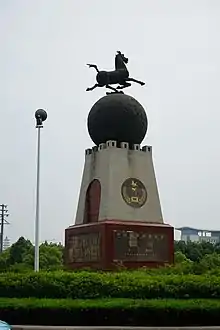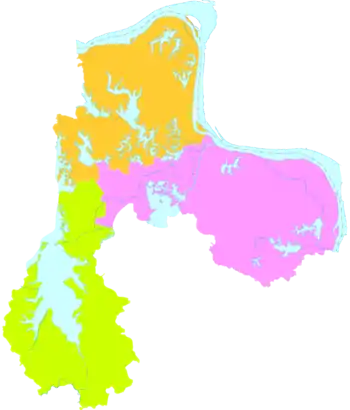Ezhou
Ezhou (Chinese: 鄂州) is a prefecture-level city in eastern Hubei Province, China. As of the 2010 census, the city had a population of 1,048,668, of which 668,727 lived in the core Echeng District. The Ezhou - Huanggang built-up (or metro) area was home to 1,035,496 inhabitants from the Echeng and Huangzhou, Huanggang Districts.
Ezhou
鄂州市 | |
|---|---|
 A view of Ezhou urban area from the top of Wuchang Tower, West Hill | |
.png.webp) Location in Hubei and the PRC | |
 Ezhou Location in Hubei | |
| Coordinates (Ezhou municipal government): 30°23′29″N 114°53′42″E | |
| Country | People's Republic of China |
| Province | Hubei |
| Municipal seat | Echeng District |
| Area | |
| • Prefecture-level city | 1,504 km2 (581 sq mi) |
| • Urban (2017)[2] | 247.00 km2 (95.37 sq mi) |
| Population (2010 census[3]) | |
| • Prefecture-level city | 1,048,668 |
| • Density | 700/km2 (1,800/sq mi) |
| • Urban (2017)[2] | 441,599 |
| • Urban density | 1,800/km2 (4,600/sq mi) |
| Time zone | UTC+8 (China Standard) |
| ISO 3166 code | CN-HB-07 |
| Licence plate prefixes | 鄂G |
| Website | 鄂州市政府门户网站 (in Simplified Chinese) |
| Ezhou | |||||||||||||||||
|---|---|---|---|---|---|---|---|---|---|---|---|---|---|---|---|---|---|
| Chinese | 鄂州 | ||||||||||||||||
| |||||||||||||||||
Geography
Ezhou lies on the southern bank of the Yangtze River east of the southern section of Wuchang, across the river from the city of Huanggang, to which it is connected by the Ehuang Bridge. Lying between the cities of Wuhan and Huangshi, Ezhou has a relatively small area of 1,504 square kilometers (581 sq mi).[4]
There are many lakes in Ezhou, including the Liangzi Lake in Liangzihu District and Yanglan Lake, along with more than 133 lakes and pools. The city is the origin of Wuchang Bream and as a result is nicknamed "city of one hundred lakes" and "the land of fish and rice".
| Climate data for Ezhou (1981–2010 normals) | |||||||||||||
|---|---|---|---|---|---|---|---|---|---|---|---|---|---|
| Month | Jan | Feb | Mar | Apr | May | Jun | Jul | Aug | Sep | Oct | Nov | Dec | Year |
| Average high °C (°F) | 8.2 (46.8) |
10.8 (51.4) |
15.1 (59.2) |
21.8 (71.2) |
27.0 (80.6) |
30.0 (86.0) |
33.3 (91.9) |
32.8 (91.0) |
28.7 (83.7) |
23.1 (73.6) |
16.9 (62.4) |
11.0 (51.8) |
21.6 (70.8) |
| Daily mean °C (°F) | 4.6 (40.3) |
7.0 (44.6) |
11.1 (52.0) |
17.5 (63.5) |
22.6 (72.7) |
26.0 (78.8) |
29.3 (84.7) |
28.6 (83.5) |
24.5 (76.1) |
18.8 (65.8) |
12.6 (54.7) |
6.9 (44.4) |
17.5 (63.4) |
| Average low °C (°F) | 1.9 (35.4) |
4.2 (39.6) |
7.9 (46.2) |
13.9 (57.0) |
19.0 (66.2) |
22.7 (72.9) |
25.9 (78.6) |
25.3 (77.5) |
21.2 (70.2) |
15.5 (59.9) |
9.2 (48.6) |
3.8 (38.8) |
14.2 (57.6) |
| Average precipitation mm (inches) | 56.5 (2.22) |
76.4 (3.01) |
106.7 (4.20) |
144.1 (5.67) |
168.6 (6.64) |
228.7 (9.00) |
234.7 (9.24) |
134.7 (5.30) |
72.6 (2.86) |
83.0 (3.27) |
60.2 (2.37) |
35.9 (1.41) |
1,402.1 (55.19) |
| Average relative humidity (%) | 77 | 77 | 77 | 76 | 76 | 79 | 78 | 77 | 76 | 75 | 75 | 73 | 76 |
| Source: China Meteorological Administration[5] | |||||||||||||
History
The name "Ezhou" dates to the Han Dynasty (206 BCE – 220 CE) and derives from the nearby ancient Zhou Dynasty (1046–256 BCE) vassal State of E. Although the administrative seat of the city changed several times, the name remained unchanged until the Three Kingdoms era (220−280) at which time it became the capital of the state of Eastern Wu ruled by Sun Quan and was renamed "Wuchang". This name remained in use as late as 1915, which proved confusing to travelers, as it was also applied to the much larger city of Wuchang, itself shortly to become part of Wuhan.[6]
Throughout China's history Ezhou has remained an important city politically, economically, and militarily with its strategic position along the middle part of the Yangtze River. It is also an important location in the history of the Pure Land Sect of Buddhism.
Administration
Ezhou has three districts:[1][7][8]
| # | Name | Chinese (S) | ||||
|---|---|---|---|---|---|---|
| Districts | ||||||
| 1 | Echeng District | 鄂城区 (the central urban area) | ||||
| 2 | Huarong District | 华容区 | ||||
| 3 | Liangzihu District (Liangzi Lake District) | 梁子湖区 | ||||
| Map |
|---|
Economy

Ezhou has six ports on the Yangtze including one than can handle up to 10,000-tonne (9,800-long-ton; 11,000-short-ton) vessels. Many important rail lines and national highways cross the area. This infrastructure make it a major logistics and distribution center. Important industries include metallurgy, construction materials, textiles, chemicals, and machinery.
Transportation

Ezhou is served by the E-Huang Expressway, China National Highways 106 and 316, the Wuhan–Jiujiang Railway and the Wuhan-Huangshi Line of the Wuhan Metropolitan Area Intercity Railway. Ezhou has two bridges over the Yangtze.
The Ezhou station, 30.363343°N 114.860499°E), located southwest of downtown, has an interesting layout, somewhat similar to that of the Secaucus Junction in New Jersey. Until 2014, there was just one rail line there: the north–south Wuhan–Jiujiang Railway, which is served by a large number of trains traveling from Wuhan to Nanchang and points further east and south (Fujian, Zhejiang, etc.). Until 2013, there were no commuter trains in per se in Hubei, but it took only about one hour (usually, with a stop at Huarong) to reach one of Wuhan's train stations (such as Wuchang Railway Station) train station from Ezhou using any of those trains. The distance from the Ezhou station to Wuchang by rail is 82 kilometers (51 mi).[9] In 2014, the Wuhan-Huangshi Line of the Wuhan Metropolitan Area Intercity Railway, the region's new commuter line system, was opened. This line, which runs east–west in the area, has crossed the Wuhan–Jiujiang Railway tracks at the right angle just south of the previously existing Ezhou station. To accommodate the new line, the Ezhou Station was expanded in 2013–2014, with platforms constructed on the new commuter line, providing a possibility for an easy transfer between the two lines. This is said to be the first station in China with this layout.[10]
The trains on the commuter line travel to the Wuhan Railway Station (56 km or 35 mi, 30–40 min from Ezhou).
The commuter line has one more station in Ezhou, farther to the east. It is Ezhou East, 64 km (40 mi) from Wuhan Railway Station.
Tourism

Ezhou has several tourism sites, including the West Hill (which is in the center of the city), and the nearby Lotus Hill. There are also three lakes, Liangzi Lake, Yanglan Lake (洋澜湖) and Honglian Lake.
References
- 鄂州市历史沿革 (in Chinese). XZQH. 7 December 2011. Retrieved 6 October 2018.
1996年,全市面积1504平方千米,{...}辖鄂城、华容、梁子湖3个市辖区,
- Ministry of Housing and Urban-Rural Development, ed. (2019). China Urban Construction Statistical Yearbook 2017. Beijing: China Statistics Press. p. 66. Retrieved 11 January 2020.
- http://www.citypopulation.de/php/china-hubei-admin.php
- 鄂州地理位置. Ezhou People's Government. March 2007.Archived 2008-09-18 at the Wayback Machine (in Chinese)
- 中国气象数据网 - WeatherBk Data (in Chinese). China Meteorological Administration. Retrieved 2020-04-15.
- 鄂州历史纪要. Xinhua. Archived from the original on 16 February 2009. Retrieved 30 September 2007.
- 鄂州市2010年第六次全国人口普查主要 数据公报 (in Chinese). Ezhou People's Government. 18 May 2011. Retrieved 2 January 2018.
六、人口的分布 全市常住人口地区分布如下:地 区 人口数(人)全市合计 1048672 鄂城区 303315 华容区 172599 梁子湖区 142608 葛店开发区(含葛店镇) 64734 鄂州开发区 31013 凤凰办 138032 古楼办 127600 西山办 68771
- 2017年统计用区划代码和城乡划分代码:鄂州市 [2017 Statistical Area Numbers and Rural-Urban Area Numbers: Ezhou City]. National Bureau of Statistics of the People's Republic of China. 2017. Retrieved 6 October 2018.
统计用区划代码 名称 420701000000 市辖区 420702000000 梁子湖区 420703000000 华容区 420704000000 鄂城区
- Ezhou (鄂州) schedule search at tielu.org Archived 2016-12-05 at the Wayback Machine
- 武黄城铁预计5月开通 武汉到黄石仅30分钟票价35元. Ifeng Hubei. 2014-04-27.
External links
| Wikimedia Commons has media related to Ezhou. |
| Look up Ezhou or O-chou in Wiktionary, the free dictionary. |

